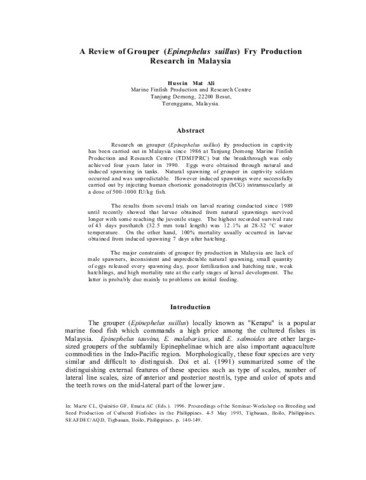| dc.contributor.author | Palma, Peter | |
| dc.contributor.author | Nocillado, Josephine | |
| dc.contributor.author | Superio, Joshua | |
| dc.contributor.author | Ayson, Evelyn Grace de Jesus | |
| dc.contributor.author | Ayson, Felix | |
| dc.contributor.author | Bar, Ido | |
| dc.contributor.author | Elizur, Abigail | |
| dc.date.accessioned | 2018-10-29T07:20:19Z | |
| dc.date.available | 2018-10-29T07:20:19Z | |
| dc.date.issued | 2019-03 | |
| dc.identifier.citation | Palma, P., Nocillado, J., Superio, J., Ayson, E. G. d. J., Ayson, F., Bar, I., & Elizur, A. (2019). Gonadal response of juvenile protogynous grouper (Epinephelus fuscoguttatus) to long term recombinant follicle-stimulating hormone administration. Biology of Reproduction, 100(3), 798-809. | en |
| dc.identifier.issn | 0006-3363 | |
| dc.identifier.uri | http://hdl.handle.net/10862/3354 | |
| dc.description.abstract | The role of follicle stimulating hormone (FSH) in the gonadal development of protogynous hermaphroditic grouper (E. fuscoguttatus) was investigated. Recombinant giant grouper (E. lanceolatus) FSH (rggFSH) was produced in yeast. Its receptor binding capacity and steroidogenic potency were confirmed in vitro. Weekly injections of rggFSH to juvenile tiger grouper for 8 weeks (100 μg/kg body weight, BW) resulted in significantly larger and more advanced oocytes (cortical alveolar stage vs. primary growth stage in control). Sustained treatment with rggFSH (20 to 38 weeks at 200 μg/kg BW) resulted in significant reduction in gonad size, degeneration of oocytes and proliferation of spermatogonial cells, indicative of female to male sex change. Gene expression analysis showed that, while initiating female to male sex change, the rggFSH significantly suppressed the steroidogenic genes cyp11b, cyp19a1a and foxl2 which restrained the endogenous production of sex steroid hormones thus prevented the differentiation of spermatogonial cells. Expression profile of sex markers dmrt1, amh, figla and bmp15 suggests that the observed sex change was restricted at the initiation stage. Based on these results, we propose that the process of female to male sex change in the protogynous grouper is initiated by FSH, rather than sex steroids and likely involves steroid-independent pathway. The cortical alveolar stage in oocyte development is the critical point after which FSH-induced sex change is possible in grouper. | en |
| dc.description.sponsorship | This study was funded by the Australian Centre for International Agricultural Research (ACIAR) through project no. FIS/2012/101 granted to A. Elizur. P. Palma was a recipient of an ACIAR funded Australia Awards John Allwright Fellowship. | en |
| dc.language.iso | en | en |
| dc.publisher | Oxford University Press | en |
| dc.subject | groupers | en |
| dc.subject | Follicle-stimulating hormone | en |
| dc.subject | Recombinant gonadotropins | en |
| dc.subject | Protogynous | en |
| dc.subject | Epinephelus lanceolatus | en |
| dc.title | Gonadal response of juvenile protogynous grouper (Epinephelus fuscoguttatus) to long term recombinant follicle-stimulating hormone administration | en |
| dc.type | Article | en |
| dc.citation.volume | 100 | |
| dc.citation.issue | 3 | |
| dc.citation.spage | 798 | |
| dc.citation.epage | 809 | |
| dc.citation.journalTitle | Biology of Reproduction | en |
| dc.subject.asfa | sex reversal | en |
| dc.subject.asfa | sex hormones | en |
| dc.subject.asfa | genetic processes | en |
| dc.subject.asfa | protogyny | en |
| dc.identifier.essn | 1529-7268 | |
| dc.identifier.doi | 10.1093/biolre/ioy228 | |
| dc.subject.scientificName | Epinephelus fuscoguttatus | en |



